
Skanderborg is a town in Skanderborg Municipality, Denmark. It is situated on the north and north eastern brinks of Skanderborg Lake and there are several smaller ponds and bodies of water within the city itself, like Lillesø, Sortesø, Døj Sø and the swampy boglands of Eskebæk Mose. Just north of the town on the other side of Expressway E45, is the archaeologically important Illerup Ådal. Over time, the town has grown into a suburb of Aarhus to the north east, connected by the urban areas of Stilling, Hørning and Hasselager.
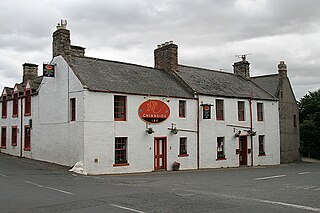
Chirnside is a hillside village in Berwickshire, Scotland, 9 miles (14 km) west of Berwick-upon-Tweed and 7 miles (11 km) east of Duns.

Klosterneuburg, frequently abbreviated to Kloburg by locals, is a town in the Tulln District of the Austrian state of Lower Austria. It has a population of about 27,500. The Stift Klosterneuburg, which was established in 1114 and soon after given to the Augustinians, is of particular historical importance.
The districts of Vienna are the 23 named city sections of Vienna, Austria, which are numbered for easy reference. They were created from 1850 onwards, when the city area was enlarged by the inclusion of surrounding communities. Although they fill a similar role, Vienna's municipal districts are not administrative districts (Bezirke) as defined by the federal constitution; Vienna is a statutory city and as such is a single administrative district in its entirety.

Bratislava Castle is the main castle of Bratislava, the capital of Slovakia. The massive rectangular building with four corner towers stands on an isolated rocky hill of the Little Carpathians directly above the Danube river in the middle of Bratislava. Because of its size and location, it has been a dominant feature of the city for centuries.

The Gürtel is a substantial beltway of Vienna. Running 13.1 km (8.1 mi) parallel to the famous Vienna Ring Road, it encompasses the inner city districts (Innenbezirke) and follows the route of the former Linienwall outer fortification. The city's red-light district is situated around the Gürtel.

Peterston-super-Ely is a village and community situated on the River Ely in the county borough of the Vale of Glamorgan, Wales. The community population at the 2011 census was 874. The community includes the hamlet of Gwern-y-Steeple.
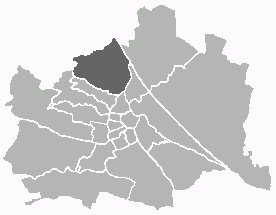
Döbling is the 19th district in the city of Vienna, Austria. It is located in the north of Vienna, north of the districts Alsergrund and Währing. Döbling has some heavily populated urban areas with many residential buildings, and borders the Vienna Woods. It includes some of the most expensive residential areas such as Grinzing, Sievering, and Neustift am Walde, and is home to many Heurigen taverns. There are some large Gemeindebauten, including Vienna's most famous, the Karl-Marx-Hof.
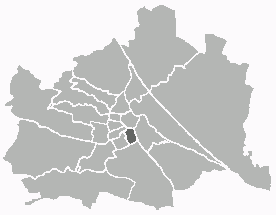
Wieden is the 4th municipal district of Vienna, Austria. It is near the centre of Vienna and was established as a district in 1850, but its borders were changed later. Wieden is a small region near the city centre. After World War II, Wieden was part of the Soviet sector of Vienna for 10 years.

Margareten is the fifth district of Vienna. It is near the old town of Vienna and was established as a district in 1850, but borders changed later. Margareten is a residential urban area, with over 25,000 inhabitants per km2, one of the most densely populated districts in Vienna. The district is named after Margaret of Antioch.

Favoriten, the 10th district of Vienna, Austria, is located south of the central districts. It is south of Innere Stadt, Wieden and Margareten. Favoriten is a heavily populated urban area with many residential buildings, but also large recreational areas and parks.
Palena is a comune and town in the province of Chieti in the Abruzzo region of Italy.
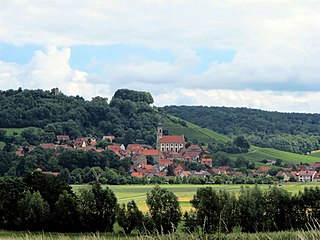
Castell is a municipality in the district of Kitzingen in Bavaria in Germany. It was the seat of the Counts of Castell. Today it is part of the municipal association Wiesentheid. It has around 800 inhabitants.

Ravengiersburg is an Ortsgemeinde – a municipality belonging to a Verbandsgemeinde, a kind of collective municipality – in the Rhein-Hunsrück-Kreis (district) in Rhineland-Palatinate, Germany. It belongs to the Verbandsgemeinde Simmern-Rheinböllen, whose seat is in Simmern. Ravengiersburg is home to the Hunsrückdom – the “Hunsrück Cathedral” – the former resident canonical foundation's church.

Waytemore Castle is a ruined castle in the town of Bishop's Stortford in Hertfordshire, England. The remains are a Grade I listed structure.
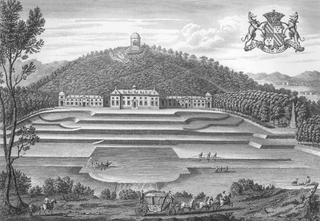
Castle Hill in the parish of Filleigh in North Devon, is an early Neo-Palladian country house situated 3 miles north-west of South Molton and 8 mi (13 km) south-east of Barnstaple. It was built in 1730 by Hugh Fortescue, 14th Baron Clinton (1696–1751), who was later created in 1751 1st Baron Fortescue and 1st Earl of Clinton, the son of Hugh Fortescue, lord of the manor of Filleigh, Weare Giffard, etc., whose family is earliest recorded as residing in the 12th century at the manor of Whympston in the parish of Modbury in South Devon. The Fortescue family became major land owners, influential in British and West Country history. Castle Hill is a rare example in Devon of an 18th-century country mansion "on the grand scale".

Ouren is a village in Belgium with a population of 129 inhabitants. Ouren is a part of the municipality of Burg-Reuland and thus belongs to the German-speaking Community of Belgium.
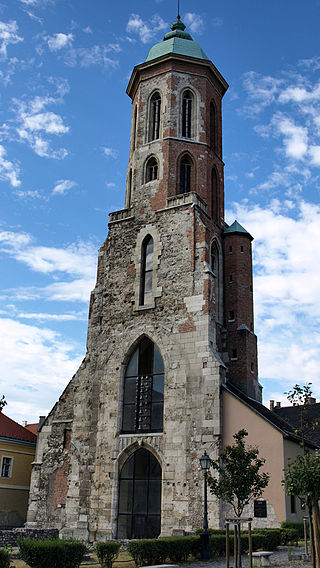
The Church of Mary Magdalene of Buda is one of the oldest churches of the Várkerület District. Dedicated to Jesus' follower, Mary Magdalene, it was built between the 13th and 15th centuries in Gothic style. Today only ruins and the tower of the church remains.

Haydnpark is a park in Vienna's twelfth district, Meidling. The park was built in 1926 on the remnants of an abandoned cemetery, Hundsturmer Friedhof, which closed in 1874 when the Vienna Central Cemetery was constructed. The park is named after composer Joseph Haydn, who was originally buried in the cemetery.

Lackalänga Church is a church in Furulund, Kävlinge Municipality, Skåne County, Sweden. It contains some of the most well-preserved early medieval church murals in Sweden.
























